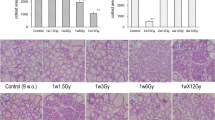Abstract
MANY tumours induced in rodents by chemical carcinogens1 and by viruses2 are antigenic in animals of the same highly inbred strain and even in the primary autochthonous host3. It has, therefore, been suggested that an inadequacy of the immune system may be a factor in allowing the growth of an induced tumour. Much evidence has been obtained in favour of such a hypothesis. Newborn animals, which have an immature immunological system, are much more susceptible to the oncogenic effect of viruses4 and of minute doses of chemical carcinogens5 than are adult animals. Chemical carcinogens have been shown to interfere with the normal immunological defences of the host6. Thymectomy of neonatal mice7, rats8 and hamsters9 leads to some impairment of immunological function, particularly homograft reactivity, and renders animals more susceptible to the oncogenic effects of polyoma virus10 and 3,4-benzopyrene11. The experiments reported here were performed to test the oncogenic activity of another chemical carcinogen, 20-methylcholanthrene, in thymectomized mice. Inbred C57BL mice from the colony maintained at the Chester Beatty Research Institute were thymectomized or sham-thymectomized on the third day of life. At approximately five weeks of age 200 µg 20-methylcholanthrene (MC) in solution in 0.2 ml. tricaprylin was injected intramuscularly into the right thigh. The animals were examined weekly and sarcomata at the injection site were measured and recorded. Mice were killed once the sarcoma reached a size of 18–20 mm diameter, examined post mortem, and material was taken for histological investigation. The results are summarized in Table 1. Thymectomized mice were examined macroscopically and microscopically for thymus remnants, but the four mice in which these were found are not included in the table. All animals, except one sham-thymectomized mouse, developed sarcomata at the injection site.
This is a preview of subscription content, access via your institution
Access options
Subscribe to this journal
Receive 51 print issues and online access
$199.00 per year
only $3.90 per issue
Buy this article
- Purchase on Springer Link
- Instant access to full article PDF
Prices may be subject to local taxes which are calculated during checkout
Similar content being viewed by others
References
Foley, E. J., Cancer Res., 13, 835 (1953). Baldwin, R. W., Brit. J. Cancer, 9, 652 (1955). Prehn, R. T., and Main, J. M., J. Nat. Cancer Inst., 18, 769 (1957).
Sjögren, H. O., Hellström, I., and Klein, G., Exp. Cell Res., 23, 204 (1961). Habel, K., Proc. Soc. Exp. Biol. and Med., 106, 722 (1961).
Klein, G., Sjögren, H. O., Klein, E., and Hellström, K., Cancer Res., 20, 1561 (1960).
Gross, L., Proc. Soc. Exp. Biol. and Med., 76, 27 (1951). Stewart, S. E., Eddy, B. E., Gochenour, A. M., Borgese, N. G., and Grubbs, G. E., Virology, 3, 380 (1957).
Pietra, G., Spencer, K., and Shubik, P., Nature, 183, 1689 (1959).
Malmgren, R. A., Bennison, B. E., and McKinley, J. W., Proc. Soc. Exp. Biol. and Med., 79, 484 (1952). Linder, O. E. A., Cancer Res., 22, 380 (1962). Prehn, R. T., J. Nat. Cancer Inst., 31, 791 (1963).
Miller, J. F. A. P., Lancet, ii, 748 (1961); Proc. Roy. Soc., B, 156, 415 (1962); Ann. N.Y. Acad. Sci., 99, 340 (1962).
Jankovič, B. D., Arnason, B. G., and Waksman, B. H., J. Exp. Med., 116, 159 (1962).
Sherman, J. D., Adner, M. M., and Dameshek, W., Blood, 23, 375 (1964).
Vandeputte, M., Denys, J., Leyton, L., and de Somer, P., Life Sciences, 7, 475 (1963). Miller, J. F. A. P., Ting, R. C., and Law, L. W., Proc. Soc. Exp. Biol. and Med., 116, 323 (1964). Malmgrem, R. A., Rabson, A. S., and Carney, P. G., J. Nat. Cancer Inst., 33, 101 (1964). Mori, R., Nomoto, K., and Takeya, K., Proc. Jap. Acad., 40, 445 (1964). Defendi, V., Roosa, R. A., and Koprowski, H., in The Thymus in Immunobiology, edit. by Good, R. A., and Gabrielsen, A. E. (Hoeber–Harper, New York, in the press).
Miller, J. F. A. P., Grant, G. A., and Roe, F. J. C., Nature, 199, 920 (1963).
Fumarola, D., and Giordano, D., Tumori, 48, 5 (1962). Prehn, R. T. (personal communication, 1964).
Fachet, J., Stark, E., and Palkovits, M., Z. Zellforsch., 60, 609 (1963). Dukor, P., and Miller, J. F. A. P., Naturwiss. (in the press).
Author information
Authors and Affiliations
Rights and permissions
About this article
Cite this article
GRANT, G., MILLER, J. Effect of Neonatal Thymectomy on the Induction of Sarcomata in C57BL Mice. Nature 205, 1124–1125 (1965). https://doi.org/10.1038/2051124a0
Issue Date:
DOI: https://doi.org/10.1038/2051124a0
This article is cited by
-
Cancer immunoediting: from immunosurveillance to tumor escape
Nature Immunology (2002)
-
Immunosuppression and neoplasia
Klinische Wochenschrift (1973)
-
Effect of neonatal thymectomy on tumour induction by adenovirus type 12 in hamsters
Experientia (1967)
Comments
By submitting a comment you agree to abide by our Terms and Community Guidelines. If you find something abusive or that does not comply with our terms or guidelines please flag it as inappropriate.



